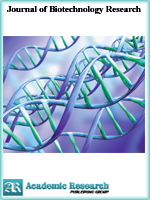Journal of Biotechnology Research
Online ISSN: 2413-3256
Print ISSN: 2413-8878
Print ISSN: 2413-8878
Quarterly Published (4 Issues Per Year)

Archives
Volume 7 Number 1 January 2021
Sire Effect on Reproductive and Growth Performance of Local and Exotic Sows In Rivers State, Nigeria
Authors: Ologbose F. I.
Pages: 12-17
DOI: doi.org/10.32861/jbr.71.12.17
Abstract
The study was conducted to determine sire effect on reproductive and growth performance of local and exotic sows in Rivers State, Nigeria. The experiment involved three breeds of pigs (Local pigs (LP), Landrace (Lr) and Large White (Lw)). Eighteen breeding pigs consisting three local sires and fifteen gilts (local and exotic) were used to generate seventy two progenies for the experiment. Reproductive performance such as Gestation length (GL), Litter size at birth (LSAB), Litter weight at birth (LWAB), Litter size at weaning (LSAW) and Litter Weight at Weaning (LWAW) were taken from the three different crosses for comparison. Data on quantitative traits such as Body weight (BW), Body length (BL), Heart Girth (HG), Height at wither (HT) and Rear Girth (RG) were taken on seventy two progenies resulting from the three crosses. The results showed significant (P<0.05) difference of sire on GL, LSAB, LWAB, LSAW and LWAW. LP x Lw performed better than LP x Lr in all the reproductive performances considered while, LP x LP recorded the least. The result also revealed that there was significant (P<0.05) effect of sire on the growth performance (i.e body weight and linear body measurements) of the progenies produced from the different three crosses used for the study, where, progenies from LP x Lr recorded highest BW and linear body measurements than progenies from LP x Lw, while, progenies from LP x LP recorded the least at week 0 (birth), 6 (weaning) and 12. The improvement in crossbred could be attributed to dominant genes from the exotic sow.
Influencing Factors of Grain Nutritional Quality and its Genetic Improvement Strategy in Rice
Authors: Bo Peng ; Qing-Xi Zhang ; Xia-Yu Tian ; Yan-Fang Sun ; Xin-Hua Huang ; Rui-Hua Pang ; Quan-Xiu Wang ; Wei Zhou ; Hong-Yu Yuan ; Fang Yang ; Juan Peng ; Hui-Long Li, Xiao-Hua Song ; Xin-Xiang A.
Pages: 1-11
DOI: doi.org/10.32861/jbr.71.1.11
Abstract
Rice is one of the most important food crops in the world, and about half of the world’s population uses it as the main food source. China’s annual rice output accounts for about 34% of the world’s annual rice output, ranking first in the world, thus China is known as the "Rice Kingdom". Rice has high nutritional value, providing the human body with 35% of the total energy intake and about 28% of the required protein. Therefore, the nutritional value of rice is directly related to human nutrition and health. In this paper, the three aspects of rice nutrition and human health, factors affecting rice nutritional quality and genetic improvement of nutritional quality of rice are reviewed. The new challenges of rice nutrition quality were analyzed, and the prospect of improving rice nutritional quality was prospected. The results provide theoretical basis for genetic improvement of rice nutrition quality and cultivation of new high-quality rice varieties in the future.



